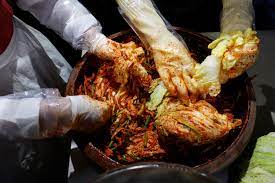
Kimchi, the iconic and beloved Korean dish, is more than just food in South Korea—it’s a cultural cornerstone, a symbol of the nation’s heritage, and a staple in nearly every meal. However, climate change is posing a serious threat to the production of the key ingredient in kimchi: napa cabbage. As rising temperatures and unpredictable weather patterns disrupt agriculture, the future of kimchi is increasingly uncertain.
See Here:
The Importance of Kimchi in South Korean Culture
Kimchi is more than just a side dish in South Korea; it is a symbol of Korean identity and tradition. Made by fermenting napa cabbage with a variety of seasonings, including chili pepper, garlic, and ginger, kimchi has been a part of Korean cuisine for centuries. It’s served at nearly every meal, from humble homes to luxury restaurants, and its preparation, known as “Kimjang,” is a UNESCO-recognized cultural practice. The potential threat to this cherished food item underscores the broader implications of climate change on cultural heritage.
The Impact of Climate Change on Napa Cabbage Production
Napa cabbage, the primary ingredient in traditional kimchi, is highly sensitive to environmental changes. The plant thrives in cooler temperatures, making it particularly vulnerable to the effects of global warming. In recent years, South Korea has experienced warmer-than-usual winters and unpredictable weather patterns, leading to poor cabbage harvests. Heatwaves, heavy rainfall, and droughts have all contributed to decreased crop yields and increased production costs.
Farmers across South Korea are reporting that the napa cabbage harvest is becoming increasingly unreliable, with some regions experiencing significant crop failures. This has led to soaring prices for napa cabbage, making it more difficult for households to afford the quantities needed for Kimjang, the annual kimchi-making season.
Economic Consequences of Disrupted Cabbage Supply
The economic impact of climate change on napa cabbage production is far-reaching. As cabbage supplies dwindle, prices have surged, placing a strain on consumers and producers alike. The rising cost of cabbage has forced many households to reduce the amount of kimchi they produce or to seek cheaper, mass-produced alternatives that lack the traditional flavors and health benefits of homemade kimchi.
For farmers, the situation is dire. Many are struggling to cope with the financial losses caused by failed crops, and some are even considering abandoning cabbage farming altogether. This shift could have long-term consequences for South Korea’s agricultural industry, which relies heavily on the cultivation of napa cabbage.
Efforts to Mitigate the Impact of Climate Change
In response to the growing threat to kimchi production, South Korean researchers and agricultural experts are exploring ways to mitigate the impact of climate change. This includes developing more resilient cabbage varieties that can withstand higher temperatures and erratic weather patterns. Some farmers are also adopting new farming techniques, such as controlled-environment agriculture, to protect their crops from the elements.
The South Korean government has also stepped in, providing subsidies and support to farmers affected by climate-related crop failures. Additionally, there are ongoing campaigns to raise awareness about the importance of sustainable farming practices and the need to protect the environment to preserve traditional foods like kimchi.
The Future of Kimchi in a Warming World
While efforts are being made to protect napa cabbage production, the future of kimchi remains uncertain. As climate change continues to alter global weather patterns, the challenges facing kimchi production are likely to intensify. The potential loss of this cultural staple highlights the broader risks that climate change poses to food security and cultural heritage around the world.
For South Koreans, the prospect of a world without kimchi is unthinkable. Yet, without significant action to combat climate change, the beloved dish may become increasingly scarce, and its traditional preparation may become a thing of the past.
Conclusion
Kimchi is more than just food for the people of South Korea; it is a vital part of their cultural identity. The threat posed by climate change to napa cabbage production is a sobering reminder of how global environmental changes can have deep and lasting impacts on local traditions and economies. As South Korea grapples with these challenges, the world watches, hoping that innovative solutions will preserve this iconic dish for future generations





